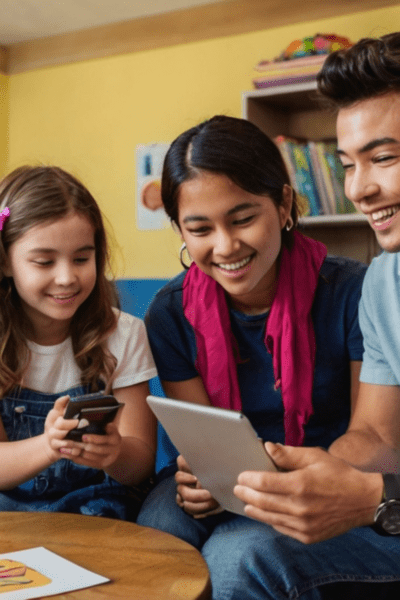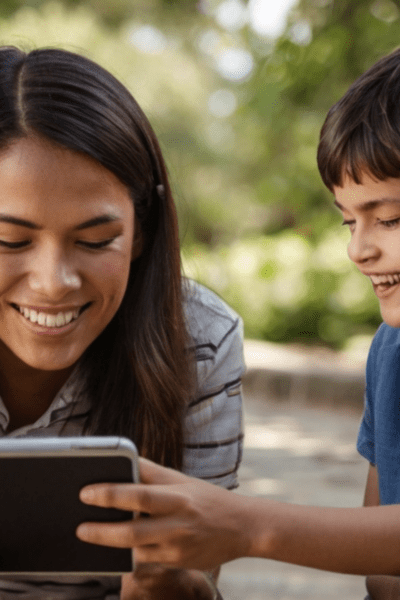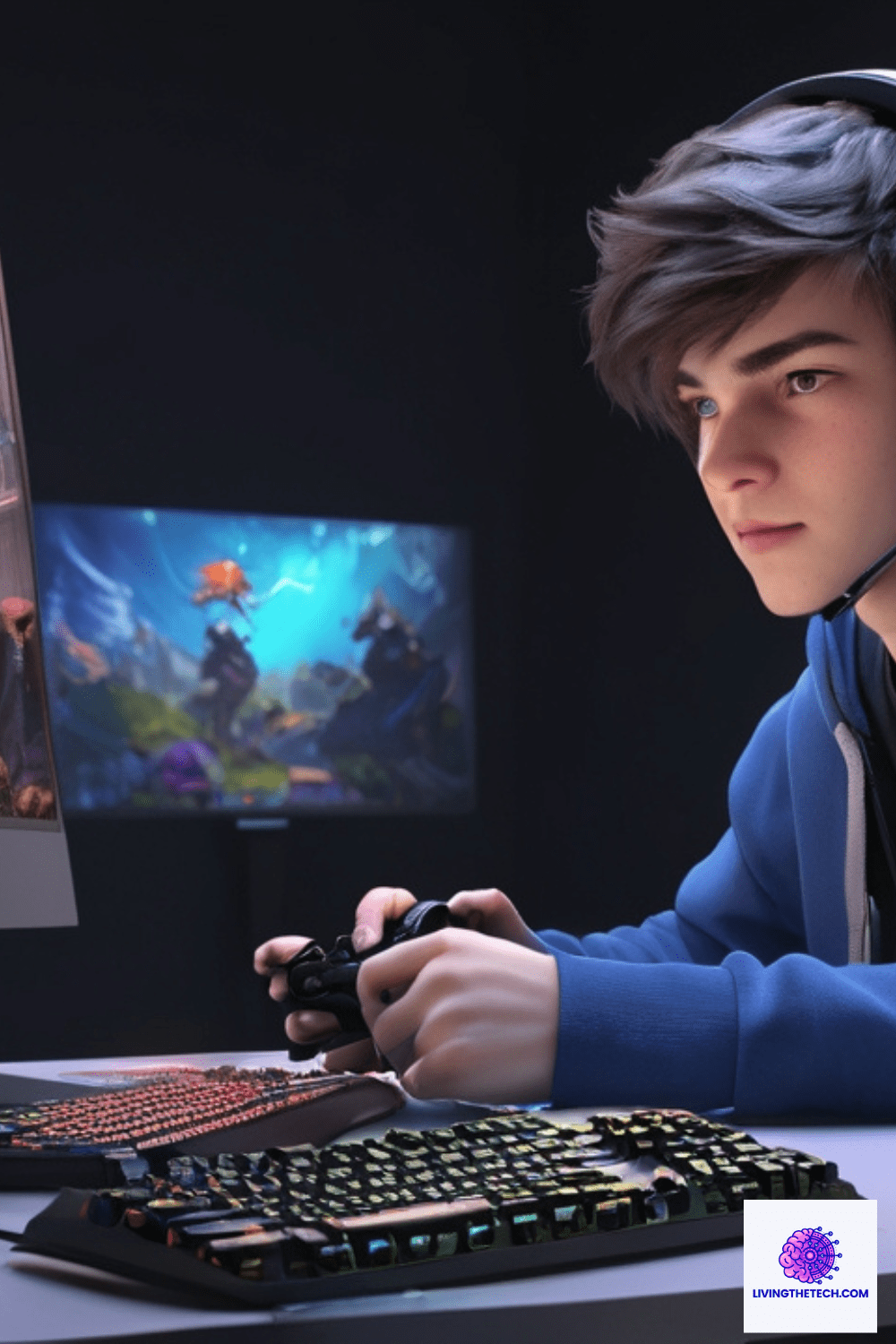Online Safety for Kids: Essential Tips for Parents
I work in technology and am a parent to two teenage boys. These are views on trying to educate yourself and your kids about the online world. Parents, don’t know your Snapchat, WhatsApp or TikTok from your Fortnite or Rocket League moves or how kids online safety works? Then read on.
If your kids are anything like mine, they want to be online playing games or updating their social media status pretty much every waking hour. The online world and being always contactable is the new “drug” of choice for most teens. It’s highly addictive, so it can be difficult for some teens to stop themselves connecting for FOMO (“fear of missing out”) or because of peer pressure.
This leads to all sorts of nasty stuff like cyberbullying, cyber predators and the inability to relax or “switch off” due to being always connected. In my day, the bell rang at school at 3 pm, and by about 3.15 pm, I was home in my little bubble of happiness without any outside “commentary” on my life and the people in it.
That said, is social media being made available to our kids at an age where they can not handle or understand what they are being exposed to? This can lead to all sorts of mental health issues, such as anxiety or body issues. Like smoking or drinking, should social media platforms come with suitable age limits and health warnings based on what they are being exposed to?
Affiliate links are in this post, more information in disclaimer

Control vs Awareness
So, what can you do? Control and track what your kids experience online, or raise their awareness and educate them on what they should be doing online. I will aim to show it is a combination of the two, but with a stronger emphasis on education and awareness rather than blocking them from the online world. I have written another blog post called Digital Parenting in a Tech World – 8 Helpful Strategies. It’s worth a read, along with this post. I prefer awareness and education, as other kids in their friend group may not have controls in place on their devices.
Digital Culture and Your Kids Online Safety
I am increasingly fascinated by digital culture, which sees our lives being interwoven with technology so that the “need” to be online has become highly addictive. Unfortunately, our kids also seem to have been sucked into the vortex of our self-created digital world, which triggers a hit of dopamine every time someone “likes” our post on Facebook or TikTok.
Our headphones I liken to an intravenous drip attached straight to our brains, so we can look at a screen and listen to music at the same time, creating sensory overload. Our kids are also fully connected to technology in their day-to-day lives through smartwatches, smartphones, iPads, laptops, Chromebooks, TVs etc. This is where parents need to set an example to their kids by taking time out from the digital world, getting outside and away from devices, and maybe even having an online or device-free day/week. Try to Take the Digital Detox Challenge: Disconnect to Reconnect.
Always online and connected
There is no escaping the need to be more connected and our feeling of a growing reliance on technology to live our daily lives. With our heads buried in our smartphones, we may see life pass us by, that treasured moment at your child’s school play or beautiful sunset (that does not need to be then posted on Instagram) or that oncoming car.
Smartphones also give us an easy way out. Picture this, you are at a family event that is “boring”, do you go and mingle, or do you stick with the only familiar face you do know, old faithful, the iPhone? This is leading to anti-social behaviour and the further blurring of lines between the real and online world, where you use one to escape the other and where our children will copy our behaviours.
Sure, we as parents can track their every move online using software such as Net Nanny, but that’s not the point, because at some stage your kids will go online without that safety net (at a friend’s house, for example), so is that really the best option?
Kids online safety awareness
So, what to do? Our kids will go online; you can’t stop that, even if it is at school, using Google Classrooms or using online education applications. But at school, they are relatively sheltered from the bad of the online world. So rather than deny, let’s educate our children and make them aware of the good and bad of what can happen when they go online.
Don’t get me wrong, the online world is full of possibilities, from creating a business, selling your stuff or finding out information for that school assignment. For your kids, it is a big, wide world available to them; they can play online games (such as Roblox and Fortnite) and talk to their mates or even ask Siri what the answer is to a hard math question.
Our kids need their parents to educate them as to the more unsavoury side of being online, such as never giving out their passwords, sharing inappropriate pictures of themselves, and unless they know who they are chatting to (i.e. one of your mates) it could be a 50-year-old pretending to be a teenager (don’t friend a stranger). Parents need to be more aware of the online world and be able to see it from their kids’ perspective. Parents, your teenagers aren’t on Facebook, which is apparently our generation’s social media platform of choice. Our teenagers are on Instagram, TikTok, Snapchat or even WhatsApp and would generally not be seen on Facebook.

The social platform that we digital parents need to be very aware of is WhatsApp; all you need is a mobile phone. Once you have downloaded WhatsApp, it requires no password, and with your smartphone, you can then start sending messages, photos or videos. Unlike other online platforms, such as Facebook or YouTube, it provides no filtering of inappropriate content.
As parents, we need to educate our kids on the darker side of these platforms, such as making sure you know who you are talking to, and never sending inappropriate content of yourselves. Encourage your kids to talk to you if they are uncomfortable with anything they see. Let them know they can block contacts if needed. Parents must also be aware of the latest social media and online trends, which is possibly a full-time job, but worth the effort, and it also makes you potentially more relatable to your kids. There is nothing quite like discussing the latest legendary card on Clash Royale or the best goal on Rocket League.
As parents, we need to educate our kids on the light and dark side of the online world #parenting #eSafety #kids online safety Share on XSnapchat
Snapchat has become a prominent platform for teenagers, offering a unique blend of instant messaging, creative filters, and real-time updates. As teens increasingly embrace this social media tool, it’s important to understand both the benefits and challenges associated with its use. Snapchat’s innovative features allow for dynamic communication and self-expression, yet they also introduce potential privacy concerns, risks of cyberbullying, and distractions. Navigating Snapchat’s impact on teenage users involves recognising how it can enhance social connectivity while also addressing its possible downsides.
As with all online platforms, there is good and bad for kids (in this case, our teenagers, as it has a 12+ age limit), providing insight into how parents and teens can maximise the app’s advantages while mitigating its risks. In hindsight, I really should have pushed out the use of these social media platforms until they were older. If you are not paying, you are the product, and these platforms push content, not based on age or appropriateness, but on algorithms.
The Good
Enhanced Communication:
- Instant Messaging: Snapchat allows teens to send quick, disappearing messages and images, which can make communication more dynamic and immediate.
- Creative Expression: The app offers a variety of filters, lenses, and stickers, enabling teens to express themselves creatively and share their unique personalities.
Social Connectivity:
- Maintaining Friendships: Snapchat helps teens stay connected with friends and peers, reinforcing social bonds and facilitating daily interactions.
- Group Chats: Teens can create and participate in group chats, making it easier to coordinate with friends for social events and activities.
Real-Time Sharing:
- Stories Feature: Teens can share moments from their day through Stories, allowing friends and family (especially if they are overseas) to view their updates in real-time and fostering a sense of closeness.
- Geofilters: Location-based filters can make sharing experiences more engaging and relevant, such as celebrating at a concert or visiting a new place.
Privacy Controls:
- Ephemeral Content: The disappearing nature of snaps can offer a sense (which can be seen as a false sense) of privacy and security, as messages and images vanish after being viewed.
- Customizable Settings: Snapchat allows users to control who can view their content and who can send them messages, offering some level of privacy management.
The Bad:
Privacy Concerns:
- Ephemeral Nature Misconceptions: The idea that snaps disappear might lead to a false sense of security and privacy, as screenshots and data recovery tools can still capture content (always be aware of what you send).
- Data Sharing: Snapchat collects and stores user data, which could be accessed or misused if proper privacy settings are not in place.
Cyberbullying Risks:
- Anonymous Messaging: Features like anonymous messaging can sometimes be misused for cyberbullying or harassment, as bullies might take advantage of perceived anonymity.
- Public Shaming: Stories and public snaps can be shared widely, potentially leading to embarrassment or public shaming if content is not used carefully.
Addiction and Distraction:
- Screen Time: The app’s engaging features can lead to excessive screen time, potentially interfering with academic responsibilities, physical activities, or face-to-face interactions.
- Pressure to Engage: The desire to constantly update Stories or keep streaks alive can create pressure and contribute to compulsive usage habits.
Inappropriate Content:
- Snapchat’s Content Risks: The platform’s nature might encourage the sharing of inappropriate or risky content, especially if privacy settings are not strictly managed.
- Exposure to Unfiltered Content: Teens might be exposed to content or interactions that are not age-appropriate, which can affect their well-being or mental health.
How can parents help with social media?
Even as our kids grow up, they are bombarded with and by social media and with all that it entails such as trolling, cyberbullying, privacy breaches, as well as getting sucked into various online platforms that are trending at the time. It is up to us as parents to educate our kids on both the good and bad of being online, and that should include a conversation about how they want to be perceived online.
Parents should also think about what they upload about their children and ask themselves, “Would my child actually thank me for sharing this once they have grown up?” Being more aware of social media trends, including privacy settings and what is trending or not, is all part of the world that parents and children now live and taking a blasé attitude to social media is no longer appropriate because it could be detrimental to you and your kids.
Kids Online Safety While Gaming
Online gaming has become a popular pastime for children, offering a world of excitement, creativity, and social interaction right at their fingertips. From adventure quests to multiplayer battles, these games provide an immersive experience that captivates young minds. However, as much fun as online gaming can be, it also brings a unique set of challenges and concerns for parents.
Issues like screen time management, online safety, exposure to inappropriate content, and balancing gaming with other activities are common worries. Understanding the benefits and risks of online gaming is key to helping children enjoy their digital adventures responsibly and safely. Let me introduce you to two of the most popular online games at the moment, Roblox and Fortnite. There are many more, but these two seem to be popular with my children.
Roblox
My kids love playing Roblox, where they can set up accounts without you knowing, so you must make sure that a parent’s email address is added to the account, as well as a PIN number, so some settings can’t be changed without it. That way, you can add some privacy settings to the account, which also allows you to reset a password and set more controls on the chat capability for that account. Roblox have also created a guide for parents which is well worth a read. The game also allows children to report abuse, but again, education and awareness between child and parent will be your best line of defence.
Roblox allows users to chat with others. While it uses content filters, inappropriate language or contact can still slip through. Parents should use the parental controls to limit or disable chat features.
Fortnite
The free online game, with zany dance moves (such as taking the L) to fancy costumes and items to buy or collect. To the uninitiated, it’s basically a “Battle Royale” where 100 players start by being dropped out of a bus onto a small island, where it’s a fight to the last person standing. As the game progresses, the playing area reduces so that players have to be in the eye of the storm.
It’s free to play, but you can make purchases through the game, so make sure you don’t put your credit card details in there if you don’t want that to occur. As it is a game played with 100 other people, your kids may hear colourful language as they are playing, something to be aware of and to again educate your kids on. Your child can join the lobby with their friends at the beginning of the game and turn off the audio of the other players while still communicating with their friends.

It’s Aimed at the Kids
Fortnite is effectively a first-person shooter, but there is no bloody violence you can get with other similar games, and the graphics and visual styling make it more kid-friendly, and they can team up with their mates. So, when you create an account, make sure you use your email address and enable 2 factor authentication so no one else can hack that account.
Games usually take around 15-20 minutes if you last the distance, so limiting your kids to 3 to 4 games in any one sitting should be enough to get their fix. Whatever you do, don’t ask them to stop mid-game; otherwise, they lose any points accumulated and let down their teammates, and more than likely, you will get a rather terse response from your child.
Talk openly about the online/social media world and what appropriate looks like, and that you are always there for them to talk about their experiences #digitalparenting #cybersafety Share on XYour Kids Online Safety
In today’s tech-savvy age, ensuring a safe and balanced online experience for kids can be challenging, expensive and time-consuming. These tips and insights are designed to help you understand the online landscape, set healthy boundaries, and foster positive digital habits. From managing screen time to protecting privacy, we offer practical advice to help you support your kids’ online safety journey while maintaining their safety and well-being. Empower yourself with knowledge and tools to create a secure and enriching digital environment for your family. These are meant as guidance only and should be tailored to you and your family. These worked for me as a parent in navigating the digital world with my kids:
12 Tips for Digital Parents:
- Talk openly about the online/social media world and what appropriate looks like, and that you are always there for them to talk about their experiences. Try creating a family digital agreement, with an example below. If you need help in creating a Digital Family Agreement: A Step-by-Step Guide.
- Educate yourself on the latest online trends and what digital well-being is; there are plenty of resources available, online searches, audio (click link to purchase) or ebooks.
- Cybersecurity awareness: Talk with your kids about not giving out passwords and checking for links or emails to websites that may not be genuine.
- Acknowledge your children’s good and bad online behaviours and set expectations.
- Educate your children on social media smarts, such as not revealing personal information, passwords, chatting with strangers or divulging credit card information;
- Understand what your children are doing online, and what games they are playing, are they suitable, and who are they talking to?
- Play the games yourself and try out social media applications before your children (remember some platforms have age limits, e.g. Snapchat is 12+. I would try to push that out as long as possible (based on the bad on Snapchat as I highlighted above);
- As a parent, try to keep up with the latest social media platforms and trends.
- Frequently check your privacy settings on your social media profiles (and also get your children to do the same);
- Get your children outside and away from the screen, maybe even screen-free days/weeks;
- Set a positive example for your children when going online and using social media, especially when your children are around you.
- For children and parents alike, set up multifactor authentication or 2FA (two-factor authentication) on all your apps so your account is harder to compromise. This setting is usually found in the security settings of the app you are using.
Helping your kids thrive in the digital age
Managing your kids’ online safety requires a proactive and informed approach, add that to all the other things we have to do as parents, and it is hard work. By setting clear boundaries, using available tools, and fostering open communication, you can create a safe and supportive digital environment for your family. Educating your child about privacy, critical thinking, and positive online behaviour equips them with the skills needed to navigate the digital world responsibly.
With these digital parenting strategies, you can balance technology with well-being and guide your child towards a healthy and secure online presence. Remember, staying engaged and informed is key to helping your kids thrive in the digital age and keeping them safe and aware when going online.
Hindsight is a wonderful thing, but should we allow our kids online access to these social media platforms at such an early age? They are exposed to potentially age-inappropriate content based on algorithms, which could lead to mental health and anxiety issues because they can’t deal with or process what they are seeing.
Further Reading Ideas
- The ultimate guide to digital wellbeing and living your best life – offline and on!Digital wellbeing is all about finding the balance between the digital world and the real world…
- This guide helps tweens and teens do exactly that, inspiring them to set their devices aside (sometimes anyway!) and start living in the here and now
- Written by digital wellbeing expert Tanya Goodin, it’s packed with positive prompts, thought-provoking science, and hands-on activities to encourage healthy habits around screen…
- A clear explanation of what the online world can be like, helping to navigate life in a world surrounded by technology
- Kids today are growing up with social media and life online, which may have differed from how their grownups grew up! Life online isn’t a bad thing, and it isn’t necessarily a good…
- This book shows kids aged 5-9 that how you hang out online can tell the whole world about who you are, and that when you show up authentically, creatively, and kindly, you can…
- Being a parent today means dealing with a lot of digital challenges, both from technology and social media
- It’s hard to keep up with the fast-changing world of technology, including social media and its effects on your family
- So if you don’t know your Snapchat, WhatsApp or Roblox from your Fortnite or Rocket League moves, or how children’s online safety works? then this is for you
Last update on 2025-12-26 / Affiliate links / Images from Amazon Product Advertising API
Protect your kids’ online safety, start using these essential tips today and create a safer digital environment for you and your family.
This post contains affiliate links, which means I may earn a commission if you make a purchase through these links. Please note that I only recommend products that I believe will add value to my followers. Your support helps keep this content free. Thank you for your understanding and support, more information in Disclaimer!
This product presentation was made with AAWP plugin.


Great article Pete – also take the phones, devices, etc away at set times – eg after 9pm. The chats that happen late at night in big groups can be so negative!
thanks Liz, agreed…especially important given this latest development of child addiction: https://www.techspot.com/news/75010-nine-year-old-placed-rehab-fortnite-addiction.html